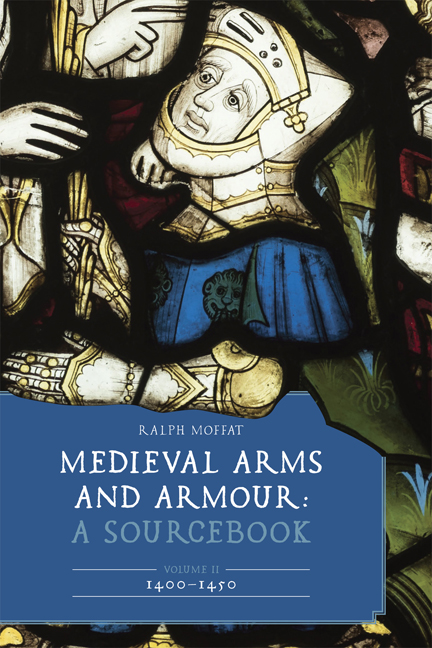Part III - Illustrated Glossary
Published online by Cambridge University Press: 16 May 2024
Summary
Advantage
pieces of (reinforcing plates) (87). See also Gardebras.
Arm defences: see Gardebras, Musekins, and Polder-mitton.
Armet (4, 16, 22, 28, 43, 70, 72, 81, 104)
a close-fitting helmet that protects the head by means of deep, hinged cheekpieces that attach to one another beneath the chin. Additional defence is provided by a visor and a reinforcing front plate, now known as a wrapper, that can be strapped on over the whole. Through our sources we can trace its origins in the Italian lands and its adoption (with a slight change of name-form) into Fr. and Eng. The name elmetto is a diminutive of Ital. elmo: helm. In the Datini accounts of 1397, printed in the previous volume, there is mention of a basinet ‘in the manner of an elmetto of the new type’ (‘a guisa d’elmetto di novella guisa’). The Datini accounts of 1400–10 have them listed as a helmet-type in their own right (4). The word ‘helmett’’ in the accounts of John, Earl Marshal, for the Agincourt campaign (43) is undoubtedly directly from the Ital. (see the discussion of Sallet below).2 The adoption of the name by Francophones is much more complicated. Changes have been made to both syllables. Firstly, as it is most obvious, the second syllable. The Ital. elmo originally derives from Old Fr. heaume, a masculine noun. Italian speakers, as demonstrated above, have applied the diminutive masculine suffix -etto. The Fr. diminutive suffix -ette, which would have served best to emulate this sound, is reserved solely for feminine nouns. Furthermore, the Fr. masculine suffix -et does not have a word-final consonant (the hard t sound). Second, the first syllable. Traces of the nasal vowel following the silent h of heaume appear in two of our sources: the ‘eaumet a Jouster’ recorded in 1427 (72) and Olivier de La Marche's ‘armet ou heaumet’ of 1449 (104). In 1404 (16) and 1421 (28) the word appears as armet, now pronounced with the open vowel a followed by a guttural r. The overall result of these linguistic changes is the finalized form armet – the form most commonly (and still) in use. Confusingly, armet is both a strong homophone and homonym of the Fr. verb armer: to arm.
- Type
- Chapter
- Information
- Medieval Arms and ArmourVolume II: 1400–1450, pp. 179 - 222Publisher: Boydell & BrewerPrint publication year: 2024

